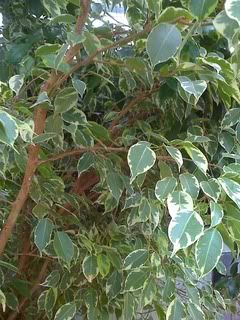Weeping Fig

The name “Weeping Fig” could easily be a reference to the countless leaves that fall like rain from Weeping Figs in homes around the world. What it actually refers to is the tree’s wonderfully arching branches and graceful elegance. Regardless of the difficulty many have had trying to grow this plant successfully indoors, Weeping Figs are incredibly popular.
 Ideally, Weeping Figs should be placed in a location where the light is bright. Some morning and late-day sun is good, though you’ll want to protect the tree from strong mid-day sun. The Weeping Fig will tolerate shadier areas, as well, though not as much as some other members of the Ficus family.
Ideally, Weeping Figs should be placed in a location where the light is bright. Some morning and late-day sun is good, though you’ll want to protect the tree from strong mid-day sun. The Weeping Fig will tolerate shadier areas, as well, though not as much as some other members of the Ficus family.
Moisture can be a bit of a touchy subject; water your tree thoroughly when the top inch of potting mix is dry. Keeping your plant properly watered is the first step toward avoiding falling leaves. It is best to use tepid rainwater. Tap water will work, but you should let it sit overnight to allow the chlorine to evaporate. Do not use softened water for houseplants. Liquid fertilizer should be used regularly, at least once a month, during the spring, summer and fall.
Moisture in the air can also be an issue for Weeping Figs. Low humidity can sometimes cause leaf loss. Group your tree with other plants, use a humidifier or use a humidity tray. Mist your tree regularly. Keep your tree away from drafts; this is another cause of leaf loss.
While on the matter of leaf loss, it should also be said that Weeping Figs naturally lose leaves annually, usually in the winter. This is normal leaf loss, though you will probably see leaves dropping at all times of the year. Do not move the tree around; once it is comfortable in a particular location, moving it will cause it to drop a lot more leaves.
Weeping Figs are fairly easy to propagate. Cuttings can be rooted in moist potting mix and lightly covered with plastic wrap to keep humidity high. Rooting hormone is extremely helpful. Air layering is another great way to propagate these trees. If you have trouble getting your cuttings to take, air layering is a reliable way to go…just expect it to take a long time.
There have been some reports of Weeping Figs causing skin irritation but it is not a common occurrence. Typically, these trees are considered non-toxic. It is always a good idea to use gardening gloves when working with plants, but if you get sap on your skin, simply wash it off with warm water and dish soap.

Moisture can be a bit of a touchy subject; water your tree thoroughly when the top inch of potting mix is dry. Keeping your plant properly watered is the first step toward avoiding falling leaves. It is best to use tepid rainwater. Tap water will work, but you should let it sit overnight to allow the chlorine to evaporate. Do not use softened water for houseplants. Liquid fertilizer should be used regularly, at least once a month, during the spring, summer and fall.
Moisture in the air can also be an issue for Weeping Figs. Low humidity can sometimes cause leaf loss. Group your tree with other plants, use a humidifier or use a humidity tray. Mist your tree regularly. Keep your tree away from drafts; this is another cause of leaf loss.
While on the matter of leaf loss, it should also be said that Weeping Figs naturally lose leaves annually, usually in the winter. This is normal leaf loss, though you will probably see leaves dropping at all times of the year. Do not move the tree around; once it is comfortable in a particular location, moving it will cause it to drop a lot more leaves.
Weeping Figs are fairly easy to propagate. Cuttings can be rooted in moist potting mix and lightly covered with plastic wrap to keep humidity high. Rooting hormone is extremely helpful. Air layering is another great way to propagate these trees. If you have trouble getting your cuttings to take, air layering is a reliable way to go…just expect it to take a long time.
There have been some reports of Weeping Figs causing skin irritation but it is not a common occurrence. Typically, these trees are considered non-toxic. It is always a good idea to use gardening gloves when working with plants, but if you get sap on your skin, simply wash it off with warm water and dish soap.
This site needs an editor - click to learn more!
You Should Also Read:
Ficus Elastica, the Rubber Tree
Fiddle Leaf Fig
Houseplants Newsletter
Related Articles
Editor's Picks Articles
Top Ten Articles
Previous Features
Site Map
Content copyright © 2023 by Lisa Beth Voldeck. All rights reserved.
This content was written by Lisa Beth Voldeck. If you wish to use this content in any manner, you need written permission. Contact
BellaOnline Administration
for details.


